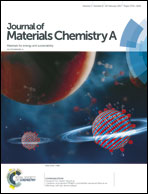Combining plasmonic trap filling and optical backscattering for highly efficient third generation solar cells†
Abstract
Metal oxide contact layers such as ZnO and TiOx are commonly used in third generation solar cells as they can be solution processed and have a relatively high conductivity. It is well known that by ultraviolet (UV) light-soaking such devices, their overall device efficiency can be boosted. This improvement in efficiency is due to high energy UV light exciting hot carriers which then fill the trap states in the metal oxide film. Unfortunately, UV causes degradation of the active layer and thus must be filtered out if long lifetimes are to be achieved. In this work, we use plasmonically excited metal nano-structures embedded in a ZnO metal oxide layer to generate hot charge carriers from visible light alone, thus removing the need for UV light soaking. Using this approach, the solar cells also exhibit better charge transport/recombination properties as well as enhanced light trapping behavior. We demonstrate that the power conversion efficiency of a low-bandgap thieno[3,4-b]thiophene/benzodithiophene (PTB7) based solar cell can be increased from 7.91% to 9.36%.


 Please wait while we load your content...
Please wait while we load your content...